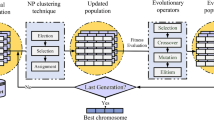Abstract
One large problem when employing a similarity function to measure the similarities between new and prior cases is to determine the weights of the features. This paper proposes a new method of learning weights using a genetic algorithm based on the similarity information of given examples. This method is suitable for both linear and nonlinear similarity functions. Our experimental results show the computational efficiency of the proposed approach.
Access this chapter
Tax calculation will be finalised at checkout
Purchases are for personal use only
Preview
Unable to display preview. Download preview PDF.
Similar content being viewed by others
References
D.W. Aha, ‘Incremental Instance-based Learning of Independent and Graded Concept descriptions’, Proc. of the 6th Intl. Workshop on Machine Learning, 387–391, 1989.
J.E. Baker, ‘Adaptive Selection Methods for Genetic Algorithms’, Proc. of an Intl. Conf. on GAs and Their Applications, 101–111, 1985.
T. Bäck, ‘Selective Pressure in Evolutionary Algorithms: A Characterization of Selection Mechanisms’, Proc. of the 1st IEEE conf. on evolutionary computation, 57–62, 1994.
J.P. Callan, T.E. Fawcett and E.L. Rissland, ‘CABOT: An Adaptive Approach to Case-Based Search’, Proc. of IJCAI’91, 803–808, 1991.
C. Cardie, ‘Using Decision Trees to Improve Case-Based Learning’, Proc. of the 10th Intl. Workshop on Machine Learning, 25–32, 1993.
J.D. Kelly and L. Davis, ‘A Hybrid Genetic Algorithm for Classification’, Proc. of IJCAI’91, 635–650, 1991.
K. Satoh and S. Okamoto, ‘Learning Weights in A Similarity Function from Distance Information’(in Japanese), Journal of Japanese Society for AI, 11, 3, 238–245, 1996.
C. Stanfill and D. Waltz, ‘Toward Memory-Based Reasoning’, Communications of the ACM, 29, 1213–1228, 1986.
M. Sugeno, ‘Fuzzy Measure and Fuzzy Integral’(in Japanese), Trans, of the Society of Instrument and Control Engineers, 8, 2, 218–226, 1972.
Y. Wang, N. Inuzuka and N. Ishii, ‘A Method of Similarity Metrics Using Fuzzy Integration’, Proc. of the 3rd Pacific Rim Intl. Conf. on AI, 2, 1028–1034, 1994.
Y. Wang, N. Inuzuka and N. Ishii, ‘Similarity Metrics on Frame Knowledge Expressions’(in Japanese), Journal of Japanese Society for AI, 10, 5, 778–785, 1995.
Author information
Authors and Affiliations
Rights and permissions
Copyright information
© 1998 Springer-Verlag Wien
About this paper
Cite this paper
Wang, Y., Ishii, N. (1998). A Genetic Algorithm for Learning Weights in a Similarity Function. In: Artificial Neural Nets and Genetic Algorithms. Springer, Vienna. https://doi.org/10.1007/978-3-7091-6492-1_45
Download citation
DOI: https://doi.org/10.1007/978-3-7091-6492-1_45
Publisher Name: Springer, Vienna
Print ISBN: 978-3-211-83087-1
Online ISBN: 978-3-7091-6492-1
eBook Packages: Springer Book Archive




